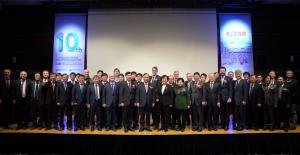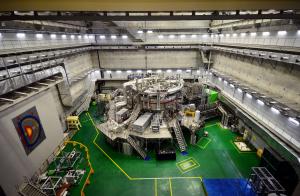Ten successful years
The recent anniversary celebration to mark the start of operations at the Korean tokamak KSTAR was the occasion to review ten years of science in the service of fusion energy.
- The ahead-of-schedule achievement of H-mode in 2010. This high-confinement regime is crucial to mastering fusion power at an industrial scale and is the operating scenario of reference for ITER.
- The achievement of full ELM suppression in 2011 by applying non-axisymmetric magnetic perturbations. ELMs (for edge localized modes), which can occur during H-mode operation, expel bursts of energy and particles from the plasma potentially causing large localized erosion to the components in contact with the plasma.
- The beginning of long-pulse, H-mode experiments (2013 ~20 s; 2014 up to 48 s; 2015 up to 55 s) extended to 70 s in 2016 (a world record at the time) and finally to 90 s in 2018 through the use of neutral beam and electron cyclotron heating, which are two of the ITER heating schemes.
- Access to fully non-inductive operation in 2015. This advanced operating mode no longer relies on the central solenoid transformer to induce toroidal current in the plasma and is key to steady state operational regimes in future tokamak devices.
- Record-length periods of ELM suppression in 2017 by the application of three-dimensional magnetic fields with internal coils, which is the same approach for ELM control in ITER.
- The achievement of 100 million degrees of ion temperature in 2018 with the demonstration of improved internal confinement through ITB (internal transport barrier mode).
With these and many more experimental results KSTAR has contributed to strengthening the physics basis for the detailed design of ITER components such as the ELM control coils, and to the planning of experimental operations described in the ITER Research Plan. This support will continue and expand already within 2019 to the important area of disruption mitigation where KSTAR will perform specific experiments to provide essential physics input to the design of the ITER disruption mitigation system., which is based on the shattered pellet injection technique—particularly on the simultaneous application of two of such systems as required in ITER. KSTAR is developing unique capabilities in this area in collaboration with experts from the USA fusion program and the ITER Organization.
The celebration on 20 February brought together over 300 people—scientists, government dignitaries, distinguished guests from the worldwide fusion community and ITER, and industry representatives. ITER Director-General, who joined the event by video conference concluded with these words:
"I offer my sincere congratulations, as well as my strong appreciation, for the great partnership that Korea and KSTAR have offered to the global fusion community and to ITER. Our future together will continue to be a future of strong partnership.
I wish you the very best for the next 10 years and beyond—strong collaboration, close partnership, and high achievement toward our common goals of a bright fusion energy future."
This celebration was preceded by the meeting of the KSTAR Physics Advisory Committee and followed up by the 2019 KSTAR Conference. In these meetings, KSTAR progress in 2017-2018 and the strategic lines for the near- and medium-term future were reviewed by an international panel of leading fusion experts, with ITER participation, and ideas for experiments in 2019 were proposed by the international network of KSTAR collaborators.



